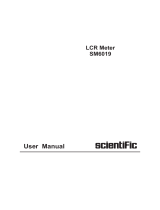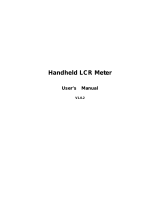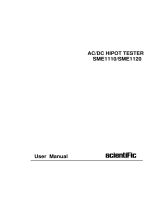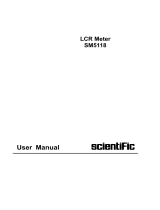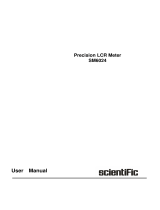Page is loading ...

♦ PRECISION INSTRUMENTS FOR TEST AND MEASUREMENT ♦
Email: info@ietlabs.com
TEL: (516) 334-5959 • FAX: (516) 334-5988
www.ietlabs.com
IET LABS, INC.
Copyright © 2017 IET Labs, Inc.
Visit www.ietlabs.com for manual revision updates
1910 im/Oct 2017
1910
Inductance Analyzer
User and Service Manual

♦ PRECISION INSTRUMENTS FOR TEST AND MEASUREMENT ♦
Email: info@ietlabs.com
TEL: (516) 334-5959 • FAX: (516) 334-5988
www.ietlabs.com
IET LABS, INC.

WARRANTY
We warrant that this product is free from defects in material and workmanship and, when properly used,
will perform in accordance with applicable IET specifi cations. If within one year after original shipment,
it is found not to meet this standard, it will be repaired or, at the option of IET, replaced at no charge when
returned to IET. Changes in this product not approved by IET or application of voltages or currents greater
than those allowed by the specifi cations shall void this warranty. IET shall not be liable for any indirect,
special, or consequential damages, even if notice has been given to the possibility of such damages.
THIS WARRANTY IS IN LIEU OF ALL OTHER WARRANTIES, EXPRESSED OR IMPLIED,
INCLUDING BUT NOT LIMITED TO, ANY IMPLIED WARRANTY OF MERCHANTABILITY OR
FITNESS FOR ANY PARTICULAR PURPOSE.
i

WARNING
OBSERVE ALL SAFETY RULES
WHEN WORKING WITH HIGH VOLTAGES OR LINE VOLTAGES.
Dangerous voltages may be present inside this instrument. Do not open the case
Refer servicing to qualifi ed personnel
HIGH VOLTAGES MAY BE PRESENT AT THE TERMINALS OF THIS INSTRUMENT
WHENEVER HAZARDOUS VOLTAGES (> 45 V) ARE USED, TAKE ALL MEASURES TO
AVOID ACCIDENTAL CONTACT WITH ANY LIVE COMPONENTS.
USE MAXIMUM INSULATION AND MINIMIZE THE USE OF BARE
CONDUCTORS WHEN USING THIS INSTRUMENT.
Use extreme caution when working with bare conductors or bus bars.
WHEN WORKING WITH HIGH VOLTAGES, POST WARNING SIGNS AND
KEEP UNREQUIRED PERSONNEL SAFELY AWAY.
CAUTION
DO NOT APPLY ANY VOLTAGES OR CURRENTS TO THE TERMINALS OF THIS
INSTRUMENT IN EXCESS OF THE MAXIMUM LIMITS INDICATED ON
THE FRONT PANEL OR THE OPERATING GUIDE LABEL.
ii

Contents
Warranty ............................................................................................................7
Specifications ............................................................................................................9
Accessories ............................................................................................................11
Safety Precautions ....................................................................................................15
Condensed Operating Instructions ........................................................................17
Installation and Power Up ..............................................................................17
Selecting Test Conditions ..............................................................................18
Zeroing ...........................................................................................................24
Connection to Device Under Test ..................................................................30
Initiating Tests ...............................................................................................30
Introduction - Section 1
1.1 Unpacking/Inspection ....................................................................................33
1.2 Product Overview ..........................................................................................33
1.3 Front Panel Description .................................................................................34
1.4 Rear Panel Description ..................................................................................35
1.5 Installation .....................................................................................................36
1.5.1 Dimensions ........................................................................................36
1.5.2 Instrument Positioning .......................................................................36
1.5.3 Power Requirements ..........................................................................36
1.5.4 Safety Inspection ................................................................................38
Operation - Section 2
2.1 Terms and Conventions .................................................................................39
2.2 Power Up .......................................................................................................41
2.3 Program/Setup Procedure (Test 1–25) ...........................................................41
2.3.1 Primary Parameter .............................................................................42
2.3.2 Secondary Parameter .........................................................................45
2.3.3 Frequency ...........................................................................................46
2.3.4 Amplitude ..........................................................................................46
2.3.5 Bias Current .......................................................................................47
2.3.6 Range Select ......................................................................................48
2.3.7 Accuracy ............................................................................................50
2.3.8 Delay .................................................................................................53
2.3.9 No. to Average ..................................................................................54
2.3.10 Primary Nominal ...............................................................................55
2.3.11 Bin Type ............................................................................................56
2.3.12 Secondary Nominal ...........................................................................59

Page 2 of 110
Contents (continued)
2.3.13 Load Correction .................................................................................60
2.3.14 Primary Load Correction ...................................................................61
2.3.15 Secondary Load Correction ...............................................................61
2.4 Program/Sequence (Test S1-S9) ....................................................................62
2.5 Utility Functions ............................................................................................64
2.5.1 Perform Calibration ...........................................................................65
2.5.2 Keypad Lockout .................................................................................69
2.5.3 Display Type ......................................................................................72
2.5.4 Numeric Format .................................................................................73
2.5.5 Trigger Source ...................................................................................74
2.5.6 Source Impedance ..............................................................................74
2.5.7 RS-232 Baud Rate..............................................................................75
2.5.8 IEEE488 Address ..............................................................................75
2.5.9 Clear All Tests ...................................................................................76
2.5.10 Leveling .............................................................................................76
2.5.11 Cable Comp. ......................................................................................77
2.5.12 Frequency Edit Type ..........................................................................77
2.5.13 Median ...............................................................................................78
2.5.14 Distortion ...........................................................................................78
2.5.15 Serial Number ....................................................................................79
2.5.16 Software Version ...............................................................................79
2.6 Error Messages ..............................................................................................79
Interface - Section 3
3.1 General ...........................................................................................................81
3.2 Remote I/O .....................................................................................................81
3.3 RS-232 Interface ............................................................................................83
3.4 IEEE-488.2 Interface .....................................................................................84
3.4.1 General ...............................................................................................84
3.4.2 IEEE-488 Connections ......................................................................85
3.4.3 IEEE-488 & RS-232 Commands .......................................................86
3.4.4 Remote Calibration ............................................................................92
3.4.5 Formats ..............................................................................................96

Page 3 of 110
Contents (continued)
Theory - Section 4
4.1 Introduction ....................................................................................................99
4.1.1 Description of 1910 Inductance Analyzer .........................................99
4.1.2 Block Diagram ...................................................................................101
4.2 Principle Functions ........................................................................................103
4.2.1 Fundamental Measurement ................................................................103
4.2.2 Sine Wave and Sampling Pulse Generator ........................................104
4.2.3 Digitization ........................................................................................104
Maintenance - Section 5
5.1 General ...........................................................................................................107
5.2 Instrument Return ..........................................................................................107
5.3 Calibration ....................................................................................................107
5.3.1 1910 Verification Procedure .............................................................107
5.3.2 1910 Verification Data Sheet ............................................................110
5.4 Diagnostics .....................................................................................................112
5.4.1 Start-up Diagnostics ...........................................................................112

Page 4 of 110

Page 5 of 110
Warranty
IET Labs. warrants that Products are free from defects in material and workmanship and, when
properly used, will perform in accordance with IET Labs.'s applicable published specifications.
If within one (1) year after original shipment it is found not to meet this standard, it will be
repaired, or at the option of IET Labs., replaced at no charge when returned to a IET Labs.
service facility.
Changes in the Product not approved by IET Labs. shall void this warranty.
IET Labs. shall not be liable for any indirect, special or consequential damages, even if
notice has been given of the possibility of such damages.
This warranty is in lieu of all other warranties, expressed or implied, including, but not
limited to any implied warranty or merchantability or fitness for a particular purpose.
SERVICE POLICY
IET Labs. policy is to maintain product repair capability for a period of at least five (5) years
after original shipment and to make this capability available at the then prevailing schedule of
charges.

Page 6 of 110

Page 7 of 110
Specifications
Measure Parameters:
Parameter Range Basic Accuracy
Low Medium High
Ls, Lp 0.001nH to 99.999H 0.5% 0.25% 0.1%
Cs, Cp 0.01pF to 9.9999F 0.5% 0.25% 0.1%
D .00001 to 99.999 0.005 0.0025 0.001
Q .00000 to 9999.9 0.005 0.0025 0.001
Y, Gp, Bp 10nS to 9999.9S 0.005 0.0025 0.001
|Z|, Rs, Rp, Xs, ESR 0.00001m to 99.999M 0.5% 0.25% 0.1%
Phase Angle -180.00 to +179.99
o
1.8
o
0.9
o
0.18
o
DCR 0.1000m to 100.00k 0.5% 0.25% 0.2%
DUT AC Voltage 20mV to 1.000V (2% +5mV) @ 1kHz
DUT AC Current 1.000A to 150.00mA (2% +5A) @ 1kHz
DUT DC Voltage 20mV to 1.000V (2% +5mV)
DUT DC Current 1µA to 150mA (2% +5A)
Test Frequency: Range: 20Hz to 1MHz
Resolution: 1.0Hz from 20Hz to 1kHz; 4 digits > 1kHz
Accuracy: (0.02% + 0.02Hz)
Speed
Accuracy Setting
Measurement Speed: 40 meas/sec Low, No Display
25 meas/sec Low
10 meas/sec Medium
1 meas/sec High
May be longer, depending on test conditions & frequency
DC measurements take 2x as long as AC measurements
Ranging: Automatic, Range Hold or Locked
Trigger: Internal (automatic)
External (via RS-232, IEEE-488 or Handler interfaces)
Manual
Source Impedance: 5, 25, 50, or 100
AC Test Signal: 20mV to 1.0V (open circuit) in 5mV steps
DC Test Signal: 20mV to 1.0V (open circuit) in 5mV steps, 5 source impedance

Page 8 of 110
Specifications (Continued)
Bias Current: Internal: 1mA to 1A in 1mA steps
External: 0 to 20A in 5mA steps (using IET Labs. 1320)
Display: LCD display with backlight
Results Format: Engineering Numeric
Deviation from Nominal of Primary Parameter
% Deviation from Nominal of Primary Parameter
No Display (for maximum throughput)
Interfaces: IEEE-488, RS-232, Handler I/O
Measurement Delay: 0 to 100s, programmable in 10 ms steps
Averaging: 1 to 1000, programmable
Mechanical: Bench Mount (optional rack mount flanges available, 2000-16)
Dimensions: (w x h x d):432x133x406mm
Weight: 8kg net, 9.9kg shipping
Environmental: MIL-T28800E, Type 3, Class 5, Style E & F
Operating: 0 to +50
o
C Storage: -40 to +71
o
C
Humidity: <75 for <+40
o
C operating
Altitude: <2000m, Installation Category 1 Pollution Degree 1
Power: 100 to 240VAC 50 – 60Hz 100W max

Page 9 of 110
Accessories
Accessories Included
Item Quantity IET Labs. P/N
AC Power Cord 1 4200-0300
Power Line Fuse (installed in instrument) 1 520049
Instruction Manual 1 150491
Calibration Certificate 1 N/A
Accessories/Options Available
Item Quantity IET Labs. P/N
Axial/Radial Component Test Fixture 1 1689-9600
4 BNC Connectors to 2 Kelvin Clip Lead Set 1 1700-03
4 BNC Connectors to 4 Banana Plugs 1 1700-04
4 BNC Connectors to 2 Chip Component Tweezers 1 7000-05
4 BNC to 4 BNC Cable Set (1 meter) 1 1689-9602
4 BNC to 4 BNC Cable Set (2 meters) 1 1689-9602-2
Low Voltage Chip Component Test Fixture 1 7000-07
Rack Mount Flanges 1 2000-16

Page 10 of 110
Accessories (Continued)
Figure A-2: 1689-9600 Axial/Radial Remote Test Fixture
H
CUR
H
POT
L
CUR
L
POT
High
Low
Chassis
1700-03
H
CUR
H
POT
L
POT
L
CUR
Figure A-3: 1700-03 BNC (4) Connectors to 2 Kelvin Clip Lead Set
H
CUR
H
POT
L
CUR
L
POT
1700-04
Figure A-4: 1700-04 BNC (4) Connectors to Banana Plugs (4)

Page 11 of 110
Accessories (Continued)
Figure A-6:
1689-9602 BNC (4) to BNC (4) Cable Set, 1 meter
1689-9602-2 BNC (4) to BNC (4) Cable Set, 2 meters
Figure A-7: 7000-07 Low Voltage Chip Component Test Fixture

Page 12 of 110
Accessories (Continued)
Figure A-8: 2000-16 Rack Mount Flanges
The 2000-16 Rack Mount Flanges (quantity 2, left and right) are used as dress panels to adapt
the 1910 to the standard 482.6 mm (19 inch) rack width. THESE FLANGES SHOULD NOT
BE USED AS SOLE MOUNTING SUPPORT OF THE 1910 in rack mount applications.
Chassis guides or other mechanical support is required to support the instrument. Chassis guides
are available from:
Amco Engineering Company
3801 North Rose Street
Schiller Park, Illinois 60176-2190
Telephone (847) 671-6670
Installation
WARNING
MAKE SURE THE UNIT HAS BEEN DISCONNECTED FROM ITS AC POWER SOURCE FOR SEVERAL
MINUTES BEFORE PROCEEDING.
1) Remove the 4 screws and washers, two each side on the front side cover.
2) Mount the two flanges using the screws and washers previously removed. Note that the
flange with the cutout is to be mounted on the right so as not to cover up the side vent holes.
Refer to the figure below.
Flange
Secure with 2
screws and
washers
Figure A-9: Flange Mounting
Left
Flange
Right
Flange

Page 13 of 110
Safety Precautions
The 1910 Inductance Analyzer can provide an output voltage to 1.0V AC and current to 1A DC
to the device under test (DUT). Although the 1910 unit is designed with full attention to
operator safety, serious hazards could occur if the instrument is used improperly and these safety
instructions are not followed.
1. The 1910 Inductance Analyzer unit is designed to be operated with its chassis connected
to earth ground. The instrument is shipped with a three-prong power cord to provide this
connection to ground. This power cord should only be plugged in to a receptacle that
provides earth ground. Serious injury can result if the 1910 Inductance Analyzer is not
connected to earth ground.
2. Tightly connect the 4 BNC test cables or test fixture to the front panel connectors. If this
is not done improper measurements are possible, or an electrical shock to the operator
could result if the DUT is touched.
3. Never touch the test leads, test fixture or DUT in any manner (this includes insulation on
all wires and clips) when the bias current is applied and the BIAS ON light is on.
4. Before turning on the 1910 Inductance Analyzer unit, make sure there is no device
(DUT) or fixture connected to the test leads.
5. Before touching the test leads or device under test make sure:
a) Any capacitive device has had enough discharge time.
b) The green BIAS ON LED is NOT lit.
6. In the case of an emergency, turn OFF the POWER switch using a “hot stick” and
disconnect the AC power cord from the wall. DO NOT TOUCH THE 1910
INSTRUMENT.
Position the equipment so it is easy to disconnect. Disconnect by means of the power
plug or power connector.
7. When the 1910 Inductance Analyzer instrument is used in remote control mode, be
extremely careful. Output voltage or current can be turned on and off with an external
signal.

Page 14 of 110
Safety Symbols
The product is marked with the following safety symbols.
!
Product will be marked with this symbol (ISO#3864) when it is necessary for the user to refer to
the instruction manual in order to prevent injury or equipment damage.
Product marked with this symbol (IEC417) indicates presence of direct current.
Product will be marked with this symbol (ISO#3864) when voltages in excess of 1000V are
present.
Indicates the grounding protect terminal, which is used to prevent electric shock from the
leakage on chassis. The ground terminal must connect to earth before using the product.
Warning Procedure can cause hazard to human if the warning is neglected.
Caution Avoid product misuse. It may cause damage to the product itself and the DUT if the
caution is neglected.
Note Important information or tips for the procedures and applications.
Warning Signal During Testing
“DANGER – HIGH VOLTAGE TEST IN PROGRESS, UNAUTHORIZED PERSONS
KEEP AWAY”
Disposal
Do not dispose of electrical appliances as unsorted municipal waste, use
separate collection facilities. Contact your local government for
information regarding the collection systems available. If
electrical appliances are disposed of in landfills or dumps,
hazardous substances can leak into the groundwater and get into
the food chain, damaging your health and well-being. When
replacing old appliances with new one, the retailer is legally
obligated to take back your old appliances for disposal.

Page 15 of 110
Condensed Operating Instructions
Start-Up
The 1910 Inductance Analyzer can be operated from a power source between 90 and 250 VAC
at a power line frequency of 50 to 60 Hz. The unit is shipped with a 2.5A fuse in place for 90 to
250 V operation. Refer to paragraph 1.5.3 for fuse location and/or replacement.
The 1910 Inductance Analyzer is designed to be operated with its chassis connected to earth
ground, a 3-prong power cored is provided with the unit to make this connection. Connect one
end of the power cord to the instrument’s rear panel power receptacle and the other end to the
proper ac power source.
Press the Power button on the front panel to the (1) position to apply power. The power can be
switched off at any time by pressing the this front panel switch to the (0) position.
Power Up
Press power switch to On (1) Unit initializes through
Steps 1 to 11
Displays software
version
To READY state
Initializing
2
IET Labs.
Model 1910 V1.4
1 Ls Rs 1.0000 KHz
1.000V NoBias Auto High
Primary
Parameter
Secondary
Parameter
Test
Frequency
AC Test
Voltage
Measurement
Range
Measurement
Accuracy
Bias
Current
Test
Number

Page 16 of 110
Programming Test Conditions
1 Prim Param Program
Automatic
1 Ls Rs 1.000kHz
1.000V No Bias Auto High
[PROGRAM]
Right
1 Prim Param Program
Ls
1 Sec Param Program
No Secondary param
Press the
UP
or DOWN
arrow to select test # (location where test conditions are stored).
UP
1 Sec Param Program
Q
Programming Test Conditions
Test # (1 - 30)
Sequence Test # (S1 - S10)
Refer to paragraph 2.4
Press
PROGRAM
to enter programming mode
Press [PROGRAM] at any
time to exit programming
mode.
Measured Parameters
Press the
UP
or DOWN
arrow to select measurement parameter
UP
Automatic, Ls, Lp, Rs, Rp, Cs,
Cp, DF, Q, Z, Y, P, ESR, Gp,
Xs, Bp, V, I, DCV, DCR, DCI
Press the
RIGHT
arrow to select secondary measurement parameter
Not shown if Primary
Parameter is set to Automatic
Press the
UP
or DOWN
arrow to enter secondary measurement parameter
UP
Ls, Lp, Rs, Rp, Cs, Cp, DF, Q,
Z, Y, P, ESR, Gp, Xs, Bp, V, I,
No secondary parameter
Frequency
Press the
RIGHT
arrow to select test frequency
1 Frequency Program
20.000 Hz
Right
Not shown if Primary
Parameter is set to DCV, DCR
or DCI
Press the
UP
or DOWN
arrow to enter test frequency parameter
1 Frequency Program
1.0000 kHz
UP
20 Hz - 1.0 MHz, 15 steps or
20 Hz - 1.0 MHz, continuous
Refer to paragraph 2.3.3
/
